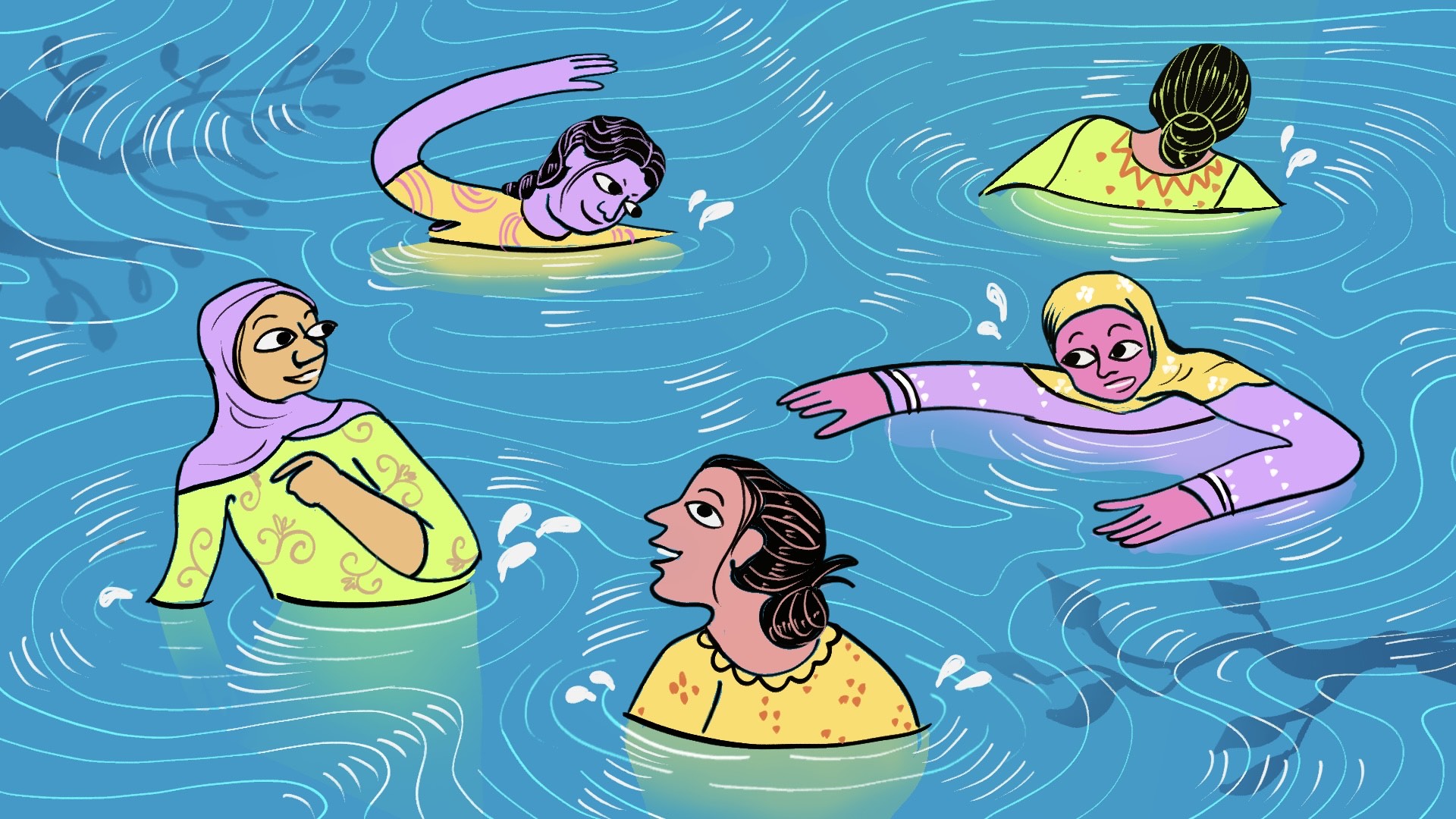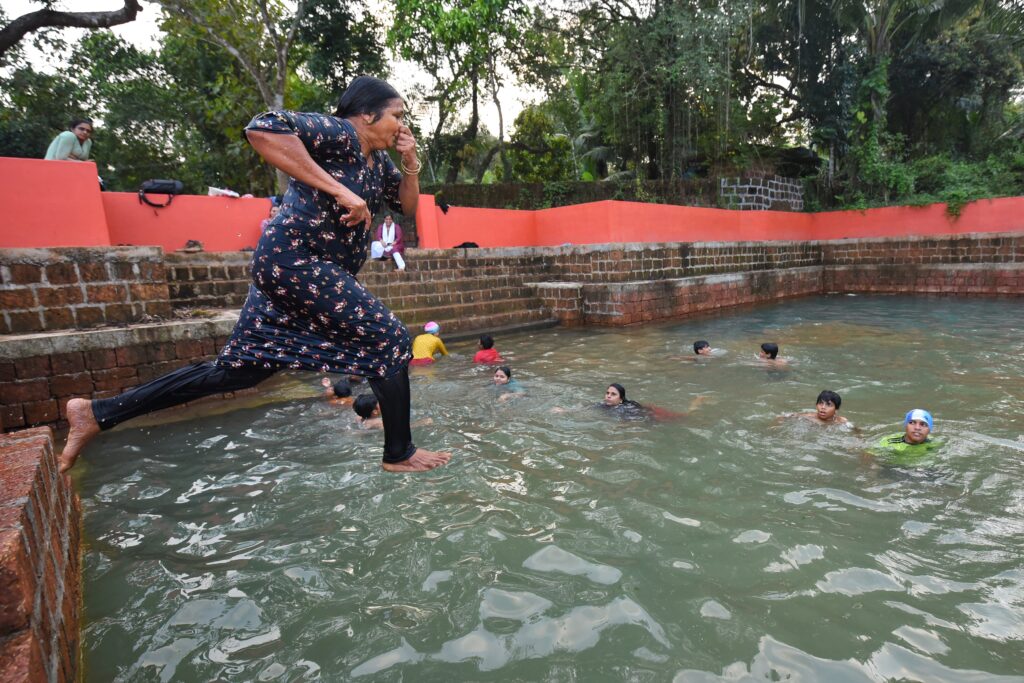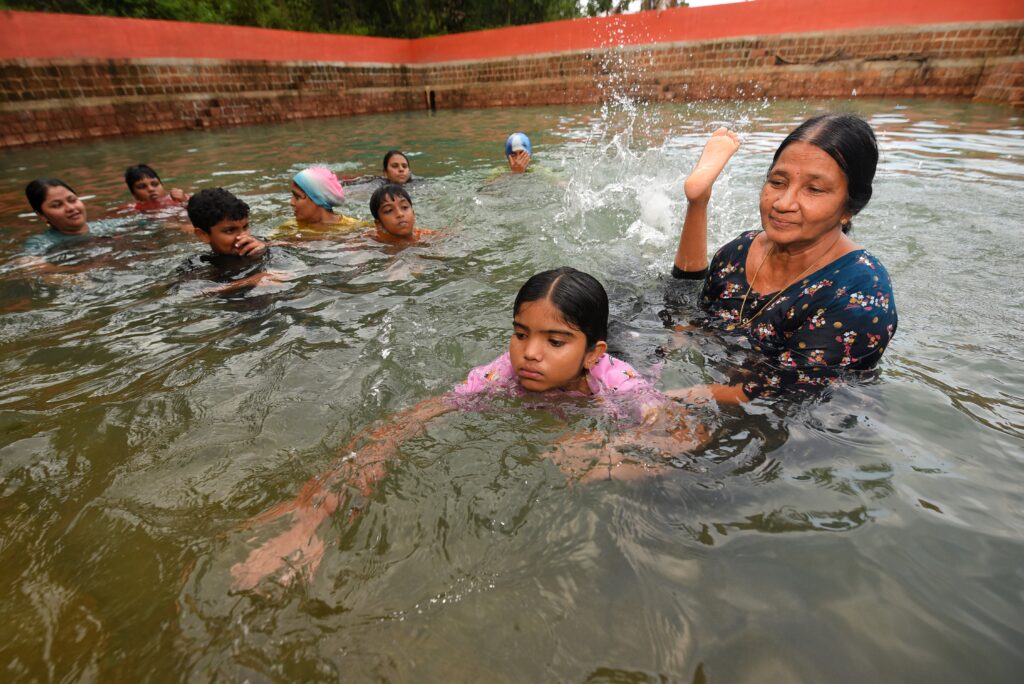When Women Swim In Joggers, Salwars, Nighties And Abayas
Bodily inhibitions deter a lot of women from learning swimming, an essential life skill and a joyous experience. Why not let them learn in whatever attire they want, asks a new breed of coaches in Kerala

As a 10-year-old, CV Janaki used to go swimming in the pond near her home in Kannur, Kerala. “I would go there with my brothers, and they would teach me how to swim,” she recalls. But, as she grew older, transitioning from childhood to adulthood, she found her love for swimming inhibited by numerous social restrictions. She gave up on it.
It was common in Kerala, a state with as many as 55,734 water bodies, for men, women and children to learn to swim in ponds and lakes near their homes. These waters were a part of the daily lives of families – this is where the women bathed and washed clothes, and where children were often flung, shrieking, by fathers and brothers, into ponds, to get over their fear of water.
The wealthy Nair tharavadus (ancestral homes) often had an attached kulippura (bath house) and popular culture is replete with stories of how women would bathe and frolic with their women friends there.
With the passage of time, and urbanisation, as the state’s social and cultural landscape changed, so did this way of life. As home construction grew rapidly, ponds were covered, and tharavadus gave way to modern homes and apartments. The loss of private or sheltered bathing spaces in neighbourhood water bodies began to keep women away from what was once a natural activity.
At the age of 52, clad in a nightie, a determined Janaki amma or Janu echi. as she is fondly called, waded into the same pond in Kannur where she had learned swimming as a child, this time with her grandchildren in tow.
It was the 2007 Thattekkad boat disaster that spurred her to return to the water. A tourist boat had sunk killing 18 people, 15 of them children. “I couldn’t help thinking that they probably would have survived had anyone taught them how to swim. And I was determined to do something about it so innocent lives would not be lost again,” says the 65-year-old.
As word spread, more people, especially women and children, began reaching out to her. Janaki, who has been conducting free swimming lessons in the neighbourhood pond, has since taught 1,822 children and women how to swim.

The demand for her classes has been such that many Muslim women from conservative families have approached her to teach them swimming. “They want to learn but are not comfortable if there are men in the pond. So, I conduct swimming classes for them in a separate pond. I let them keep their hijab on,” she says.
Her ‘student’, Museedha Shuhaid, 36, who began coming for classes along with her sister-in-law Saajida Shahul Hameed, says that, as a child, she always wanted to learn swimming. “But I wasn’t allowed to do so. Now the times have changed, and my husband is supportive,” she says, adding that she wears leggings and a top while swimming. “Many of the women from my community are now coming for swimming lessons. Who knows, one day it may save lives.”
Women’s Hour In City Pools
There are several swimming pools in Kerala’s cities now but women and girls stayed away because of inhibitions. Women’s hesitation in learning swimming is not limited to Kerala. The terror of the swimsuit is visible everywhere in India, including touristy Goa. You can find rows of tailors, not far from the beach, attaching sleeves and fabric to swim suits to make them more “modest”, especially ensuring that the thighs and arms are covered.
In Chennai, where I live, hotels offer swimming classes. But many women hesitate to come when there are men around, preferring “ladies’ classes” that are held usually in the afternoon. A number of apartments and condos that have pools also reserve a time of day when only women get to use the facility.
There are few affordable, clean and accessible facilities in cities where women can learn to swim. I come from Kerala but I didn’t have the opportunity to use the family pond. After a few failed childhood attempts at learning swimming, as a young reporter in Chennai, I signed up for a summer swimming camp at a small hotel. The pool was small, dirty and filled with people of all age groups. The blazing heat, shrieking children with dripping noses, and men leering as they gargled into the pool’s gutter ensured that I came down with an infection. I opted out soon.
Years later, determined to master swimming, I signed up for classes for adults in a star hotel. That’s where I met the women who were determined to battle all odds to learn the skill – a granny who was learning swimming so she could enjoy her Bali holiday with family, and three young Marwari women, all fully covered in modest, full-sleeved swimsuits that also covered their legs right up to their ankles, revelling in their newfound freedom post marriage.
“Our parents never allowed us to learn swimming, they would say we can do whatever we want after we get married,” one of them told me, laughing. “We are all related by marriage, and our husbands are very progressive and encouraged us to learn swimming so that we can also enjoy beach vacations.”
They had been taking lessons for two months, struggling to master swimming but not ready to give up. “We can learn to float now, someday we shall learn to swim too,” said the spirited granny who hails from a Maharashtra village. “I couldn’t have dreamed of learning to swim in the presence of men, especially under the guidance of young male coaches. And just look at me now,” she pointed out with a cackle.
A few other women in their 50s, freed from household chores with the advent of their daughters-in-law, agreed heartily. “We spent our youth in kitchens, caring for in-laws and children. Now, we have earned the right to relax,” said a 58-year-old, who had signed up for classes along with two of her friends. “We have overcome inhibitions as we grow older – this has been a very liberating experience. Next, we are planning to sign up for Zumba classes.”
Learning in Periyar
Swimming is a life skill but few Indian women choose to master it, says Lopa Ghosh, senior communications advisor at Global Health Advocacy Incubator (GHAI). The lack of privacy in swimming facilities, high cost of training, which is usually more easily available in urban areas, stereotypical notions that deter girls and young women from participating in physical activities. This is even more true of rural women.
With fewer people mastering the survival skill, many lives are lost to drowning. Official data puts the number of those who died of drowning in India in 2022 at 38,503. In Kerala, according to the State Crime Records Bureau’s response to an RTI, drowning claimed 10,451 lives between 2016 and 2021, of them 8,169 in accidents and 2,282 in suicides. Last April, Ernakulam district alone reported 27 deaths.
“Women are at high risk of drowning due to socio-economic factors that shape their interaction with water – such as farm labour, collecting water, washing clothes in unsafe water bodies. Yet due to social norms and traditional gender roles women and girls fail to benefit from swimming lessons,” says Lopa.
That’s why a few people like Janaki amma have been determined to impart the skill to others, especially women, who have to battle taboos and patriarchal restrictions to learn the skill. And life seems to have come full circle, as they are doing it not in fancy Olympic sized pools but lakes and rivers, in attire that women are comfortable in.

Many women throng Saji Valassery’s classes, which are held in the Periyar river from November 1 to May 31 every year, before the monsoons begin. “Our female students wear jogging pants, and collared T-shirts. And we insist that someone from their family accompanies them, so that they feel safe,” says Valassery. “If they want to wear a hijab, we allow it.”
For instance, his ‘student’ Aluva-based Arifa VK swims in an abaya, a swimming cap keeping her hijab in place. “I put pins, so it won’t budge. The abaya also ensures I remain modest when I step out of the water,” she says. “Women hesitate to swim as they think they have to wear swimsuits, but I have proved it’s not necessary.”
She began learning swimming when she was 67. “The Kerala floods happened when my husband and I were away on Hajj in 2018. My family was evacuated by boat and it almost capsized. None of them knew swimming. When I heard that, I immediately sent my grown-up sons to Valassery’s swimming classes,” says Arifa, who is now 72.
Valassery established Valasseril River Swimming Club in 2010 in Aluva and began offering free swimming classes after reading about the Thekkady boat tragedy. In 2009, a double decker boat carrying 78 tourists capsized, and 45 people died.
Buoyancy As Meditation
After Arifa’s sons and their wives learned how to swim, she took her grandchildren to the class. Seeing so many people in the water inspired Arifa to join the classes, and she began learning in 2019. In 2021, she made news when she swam across the Periyar, hijab in place. The next year, at the age of 70, she crossed the river again, this time with her hands tied.
“At my age, it’s easier to swim in the water than walk on land,” laughs Arifa. For most of the women, learning to swim has also been rejuvenating, opening the door to freedom and a healthy lifestyle. “I am so tired after class that I sleep soundly at night. The insomnia I have been suffering since hitting menopause has completely disappeared,” says the 58-year-old at the Chennai pool.
Swimming has long been considered moving meditation. I tried to learn yogic meditation but actually found the meditative state in the breast stroke, the first style I was taught by my coach. Stretch out your arms, pull the water back, come up for air, kick out … again and again. The trick, I realised, is to let yourself go, tune everything out, take it slow and not worry about reaching the other end of the pool. As I concentrated on the feel of the water, and the rhythm of my breath, I began feeling totally relaxed. At the end of the hour, I found myself tired but elated, and strangely peaceful and calm.
For Museedha and friends, overcoming their fear of water has boosted their self-confidence. “I used to be scared of water, but I love it now. In a way, learning to swim has helped me become stronger mentally,” she says. “We had been going to the gym to keep fit, but prefer swimming now.”
We believe everyone deserves equal access to accurate news. Support from our readers enables us to keep our journalism open and free for everyone, all over the world.

